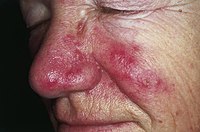
Photo from wikipedia
Dear Editor, Recalcitrant head and neck erythema (RHNE) is an adverse effect that has been observed in patients treated with dupilumab with a frequency that varies from 3% to 10%.… Click to show full abstract
Dear Editor, Recalcitrant head and neck erythema (RHNE) is an adverse effect that has been observed in patients treated with dupilumab with a frequency that varies from 3% to 10%. However, currently its management remains a challenge. Herein, we present a patient suffering from RHNE who presented a fast, sustained, and dramatic improvement of the erythema using brimonidine tartrate 0.5% plus hydrocortisone 1% ointment. A 14-year-old adolescent was referred to us due to severe atopic dermatitis. Previous systemic treatments, included oral corticosteroids, phototherapy and cyclosporine 5 mg/kg, that were stopped due to intolerance or lack of responsiveness. We started treatment with dupilumab 300 mg every 2 weeks after an initial loading dose of 600 mg. He experimented a dramatic improvement of his atopic dermatitis but from the beginning he developed a severe and symptomatic RHNE (Figure 1A). This reaction was causing important emotional disturbance to our patient. Initially, we recommended to keep it under observation, but the erythema persisted. Topical corticoesteroids were prescribed (hydrocortisone 1% ointment) with no favorable response. We prescribed the following subsequent treatments every 2 weeks: Topic tacrolimus 0.1% ointment, ketoconazole 2% cream, miconazole 2% plus hydrocortisone 2.5% cream, ivermectin 1% cream and oral itraconazole 100 mg every 12 h without a positive response. Finally, a new treatment was attempted with topic brimonidine 0.5% plus hydrocortisone 1% gel-cream once a day, reaching an almost complete response after a few hours. After 2 weeks of daily treatment the prescription was reduced to one or two times per week as needed. The response was sustained without any relapse in a 6-month follow-up (Figure 1B). The etiology behind RHNE remains unclear. Interestingly, one study showed that an elevation of interleukine-4 (IL-4) was related with higher levels of nitric oxide (NO) and vasodilation. Brimonidine is an α2-adrenergic receptor (AR) agonist that has been employed in the treatment of facial erythema in rosacea. Brimonidine has been associated with both vasodilation and vasoconstriction effects. The endothelial release of NO, via endothelial α2-AR activation, can modulate the contractile action of α2-AR associated with NOmediated vascular response. In animal models, brimonidine caused dose-dependent constriction in the microvessels of the naive hamster cheek. The magnitude of vasoconstriction response to brimonidine is inversely related to vessel size. In our opinion, Brimonidine tartrate 0.5% plus hydrocortisone 1% could be helpful in treating RHNE.
Journal Title: Dermatologic Therapy
Year Published: 2022
Link to full text (if available)
Share on Social Media: Sign Up to like & get
recommendations!